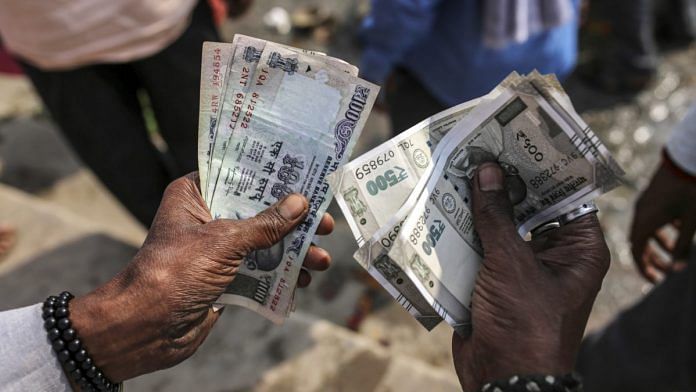New Delhi: The Indian rupee fell below the psychologically important 75 level mark to a dollar to hit record lows after massive risk aversion saw investors turning to the dollar as a safe haven.
The Indian rupee, along with the Japanese yen, Pound sterling, Australian dollar, Brazilian real and other Asian currencies like the Thai baht, Malaysian ringgit and the Indonesian rupiah have all fallen sharply against the dollar in the last few days. This is despite the sharp rate cuts by the US Federal Reserve.
On Thursday, the rupee fell to a record low of 75.30 during day trade, before recovering marginally to close at 75.12. The fall in rupee comes at a time that Indian stock markets have fallen more than 18 per cent in the last four trading sessions.
A fall in rupee will make exports cheaper and thereby competitive and imports expensive. However, a sharp fall in oil prices should come as a respite to India and lower its import bill.
Crude oil prices fell to less than $30 a barrel which will provide a huge respite to India and ring fence it against a risky volatile market.
A falling rupee is good news for sectors like information technology, textiles, handicrafts and leather. But the extent of the benefit will depend on global demand and growth, both of which are subdued due to a near halt in economic activity seen across service sectors like aviation, hotels and the tourism industry.
Also read: Sensex plummets over 2,100 points, Nifty drops below 7,900 as coronavirus carnage continues
Falling oil prices positive for crude imports bill
A report by rating agency Crisil on 18 March had pointed out how India’s oil import bill could come down to $65-70 billion in 2020-21 from $103 billion in 2019-20 and $112 billion the previous year.
“On the one side, global slowdown is having a ripple effect on India’s growth and exports. But on the other, low prices is positive for the crude imports bill. If prices move in the $35-40 per barrel band, the oil import bill would fall ~8% on-year in fiscal 2020 and 35-40% in fiscal 2021,” the report said.
In addition, the government may get some fiscal headroom as falling oil prices could give the government more space to increase excise duty on petroleum products without increasing the final prices for consumers.
Ajay Sahai, Director General of the Federation of Indian Export Organisations said that along with the depreciation in the rupee, currencies of many other countries are depreciating at a faster pace.
“I don’t think there will be much gain to any of the exporters. Currencies of our competitors like other Southeast Asian countries and Brazil are also depreciating against the dollar. The new orders are also extremely low as demand has fallen due to the spread of the Coronavirus,” he said.
In the past one month, while the Indian rupee has depreciated by 5 per cent against the dollar, the Brazilian real has fallen by 19 per cent, the Malaysian ringgit has depreciated by 5 per cent, the Thai baht by 4 per cent and the Indonesian rupiah by 13 per cent.
He pointed out that India’s traditional exports like textiles, leather, handicrafts, marine and agricultural products have a huge market in Europe, where demand has virtually collapsed courtesy the lockdown announced in most countries to battle the pandemic.
India’s external sector not vulnerable
Currency market participants and economists expect the rupee to fall further with investors preferring dollars in the coming weeks but point out that India’s external sector is not vulnerable. In addition, the Reserve Bank of India’s dollar swap window is also likely to provide some support to the rupee.
Care ratings, a credit rating agency, in a note on Thursday, pointed out that the overall external situation of the country is ‘fairly robust’ in terms of both the current and capital accounts.
“The trade deficit has been improving aided by softening commodity prices though pushing exports remains a challenge. Foreign investment and ECBs have provided support to the capital account, and the net accretion to forex reserves reinforces the strength of this balance. The RBI has taken positive steps to counter the present volatility which will help to an extent. However, the global factor of stronger dollar relative to most currencies will continue to weigh on the rupee,” the note said.
India’s forex reserves were at a record $487 billion as of 6 March covering more than a year of India’s imports. The current account deficit has also been falling and was at one percent of GDP in the April-December period as against 2.6 per cent in the previous year.
Also read: Indian economy faces bigger risk from coronavirus because it is informal




Brings to mind all those tasteless remarks / jokes, comparing it to Dr Singh’s age.
One expects The Print to give anti-Modi narrative, however mild and therefore, one reads it to get what sickulars and anti-establishment are shouting and howling about. This article is surprisingly professionally written giving a nuanced view. Hopefully, it does not disappoint Modi trolls and bhakts!!